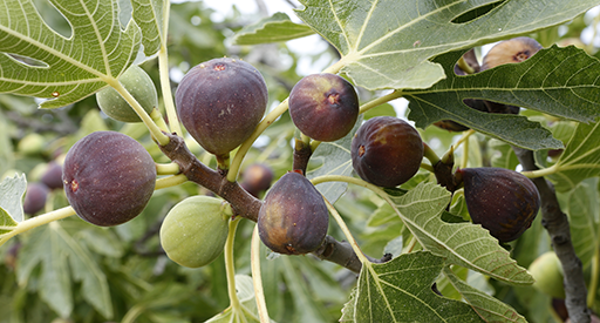
5 Steps to Fig Success
- Choose a sheltered, frost free spot with free draining soil and maximum sun.
- Dig in generous amounts of compost and pellets when preparing the soil.
- Figs are best planted from autumn to spring in New Zealand.
- Feed in spring with a nitrogen and potassium rich fertiliser for healthy growth and plentiful fruiting.
- Mulch and water well, particularly in summer.
Follow our full guide below to a bumper crop of homegrown figs.
Delicate figs don't travel well which is why the fruit costs so much in store and also why it's a great idea to grow your own! The fig's lush, dark green leaves bring tropical vibes to your space and are a welcome addition to any garden, providing you consider that they can grow up to 15 metres high! (but are more likely to be 3-9 metres).
Prepare
Figs are easy to grow in free draining soil that is enriched with generous amounts of organic-rich compost and sheep pellets. A sheltered frost-free position with maximum sun is best for ripening fruit in summer and autumn. The hotter and drier the summer months, the better the fruit yield.
In cooler regions plant against a sunny wall or sheltered corner for extra protection. Once established, figs can withstand temperatures as low as -10 degrees, however you must provide frost protection to newly planted trees in winter. Fig trees are deciduous and so lose their leaves in winter.
The common fig (ficus carica) is the best variety to grow at home as the fruit is a receptacle with an infertile flower inside so they don’t require pollination. A tree will start producing fruit when 2-3 years old, fruiting in spring and in autumn, and can fruit continuously throughout the growing season especially if planted in the right spot.
Figs are grown on their own roots from cuttings, they do not require a rootstock.
Other fig varieties include:
Mrs Williams - Ideal for pots with a sweet flavour and dark skin colour. An early variety.
Brunswick - Cold hardy, long pear-shaped brown fig with sweet flesh. Fruits in summer and autumn.
Vlassof - A hardy ‘Honey Fig’ with sweet flesh that produces two crops.
Brown Turkey – A hardy, heavy bearing, good all-round variety for eating and preserving.
Plant
Figs have wide spreading invasive roots, so avoid planting near pipes or buildings. While they don’t like wet feet, clay soils are good for figs to help restrict the roots and prevent excessive leafy growth. Consistent watering throughout the growing season and mulching will ensure quality fruit.
Planting figs in the garden:
- Dig a hole 3-4 times bigger than the root ball.
- Dig in generous amounts of Tui Compost and Tui Sheep Pellets, then add Tui Citrus & Fruit Mix to the planting hole.
- Gently loosen the root ball, place plant in the centre of the hole.
- Fill with Tui Citrus & Fruit Mix to the same level as the original pot.
- Gently firm and water in well.
- Provide a support for the tree, they can be grown in a fan shape against a sunny wall.
Planting figs in pots and containers:
Growing figs in pots and containers is a good way to restrict the roots, and they won't grow as big as figs grown in the garden. Planting in pots or containers is a good way to grow figs in marginal cooler regions, as they can be moved in winter to protect from frost and snow. Plant in a large pot or half wine barrel.
- Partly fill the container with Tui Citrus & Fruit Mix.
- Gently loosen the root ball of your plant.
- Place your plant in the centre of the container, and fill in with Tui Citrus & Fruit Mix to the same level of the previous container.
- Water regularly and consistently and repot every 2-3 years.
Nourish
Feed your plants and they will feed you. Figs generally don’t need a lot of fertiliser, feeding with a balanced fertiliser such as Tui Novatec in spring is all they need.
Figs grown in containers require more regular feeding. Feed with Tui Enrich Fruit, Citrus, Tree & Shrub controlled release fertiliser every 12 weeks in the growing season.
For supercharged feeding with quick visible results try Tui Citrus & Fruit Liquid Superfood - perfect for pots & containers too!
Harvesting
Figs fruit when 2-3 years old. Fruit is ripe when it gives in your hand and the neck starts to shrivel, wilt and bends over.
Generally, depending upon variety, fruit ripens in December or January and main crops ripen March or April. The first crop in December is referred to as the breba crop which is ripened fruit from the previous autumn. The second crop is fruit that has developed from new spring growth.
Pruning
Figs are best trained to a vase or fan shape. Too much pruning can encourage a lot of leafy green growth. Prune to keep the tree open allowing plenty of sunshine in to ripen fruit. Avoid winter pruning as this is next season fruiting wood.
In spring pinch the growing tips so the tree’s energies go into producing fruit and not excessive growth.
In summer cut back over-vigorous new season growth to 4-5 leaves. Remove any suckers that appear from the base of the tree to maintain a compact tree.